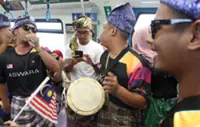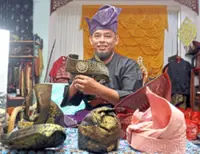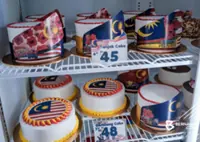Popularity of traditional headwear growing with push to preserve craft rooted in history
The tanjak has seen a resurgence in popularity in recent years, with variations of this traditional Malay headwear − typically worn with baju Melayu − showing up at more events in recent times.
Also known as destar, tanjak stands out from other traditional headwear such as getam, semutar and songkok, with its history connected to nobility.
ALSO READ: Silat, horseback archery keep tanjak-wearing tradition flying high
For Muhammad Shahrizal Daud, 43, a teacher and former silat practitioner, wearing tanjak began as a cultural expression rooted in his love for Malay heritage.
He first donned tanjak in his youth during silat classes, but his appreciation deepened through a strong interest in history at school.
His love for stories like Hikayat Hang Tuah and the Melaka Sultanate history, coupled with his fascination for classic Malay films, only fuelled his interest in the subject.
During the movement control order in August 2021, Shahrizal began to immerse himself in the world of tanjak, proudly wearing it during cultural events.
This included Keretapi Sarong, held annually in conjunction with Malaysia Day that drew thousands of participants in traditional attire.
Tanjak maker Mohamad Johari Al Fawaris, 43, said since he started in 2017, business had been growing steadily.
For Hari Raya this year, he recorded sales of up to RM15,000.
“Outside the Ramadan period, I usually earn around RM2,500 to RM3,000 a month,” he said.
Some of his top-selling designs include Semangat Bugis, Pancung Tak Bertanya, Gajah Mengamuk, Solok Timbo and Putera Kayangan.
These are popular not only for their bold, commanding appearance, but also their names, which were rooted in Malay folklore, he shared.
Preserving its origins
Today, there are two main types of tanjak – Tanjak Warisan (heritage tanjak) and Tanjak Kreasi Baru (derivative creation).
The revival of the heritage tanjak is tied largely to efforts made to preserve the craft more than a decade ago.
In 2009, the late Siri Neng Buah, who was then National Heritage Department Intangible Heritage Division director, appointed Dr Johan Iskandar Abdul Karim to spearhead efforts to bring back the nearly extinct Malay tanjak heritage.
Johan, who prior to his appointment had been teaching people how to make the headgear, spent years researching the topic to strengthen his knowledge on the subject.
He had conducted over 500 workshops on Malay traditional clothing and other cultural activities, involving some 13,000 students across Malaysia, Singapore, Indonesia, Brunei, Australia and Thailand since 2003.
He said many of his students had gone on to open their own boutiques or sell tanjak part-time.
Prices for a piece typically range from RM80 to RM250, with some students earning up to RM40,000 during Ramadan and Raya.
However, Johan said the rise of Tanjak Kreasi Baru, has made it more difficult to preserve the tanjak’s heritage as it often ignored the traditional folding techniques passed down through generations.
“This trend has disrupted efforts to preserve the authentic folding methods of our heritage,” he said.
To document and safeguard these practices, Johan has authored three books on traditional Malay headwear and garments.
Through a rigorous vetting process by universities and heritage boards, over 300 designs of destar were reviewed, with only about 105 approved based on historical evidence, including vintage photographs and early documentation.
In 2018, Johan recorded a peak in the tanjak’s popularity as it became common not only at weddings but also during festive celebrations, open houses and other events.
When StarMetro met him, he was wearing a Gajah Gemulong tanjak – a style typically reserved for those who have taught over 3,000 students in their lifetime.
The tanjak, he added, had deep roots and was even worn by officials during the Melaka sultanate.
Johan, who is founder of Akademi Seni Tradisional Warisan Melayu, is also working with Universiti Malaya’s Academy of Malay Studies this year to promote the tanjak.
The UM Academy of Malay Studies dean Associate Professor Dr Sabzali Musa Kahn said he encouraged the wearing of tanjak, even if it was the more accessible Tanjak Kreasi Baru.
“The Tanjak Kreasi Baru is more affordable, but those who are truly interested in its cultural roots will eventually gain a deeper appreciation and gradually shift toward wearing the Tanjak Warisan,” he said.
Wearing the tanjak
Made from cloth, the tanjak’s essential feature is a knot or simpul.
The word “tanjak” is derived from the Malay phrase tanah yang dipijak, which translates to “the land where one steps.”
According to Johan, the tanjak existed long before the introduction of kain songket (woven fabric with gold or silver threads).
It was only in the 1800s that kain songket began to be used for making the tanjak.
The cloth for making tanjak must be square-shaped at the start of the crafting process, and include a base during its initial formation.
Each tanjak carries its own meaning or characteristic.
For example, Nakhoda Trong and Tok Beruas tanjak styles symbolise pride or fierceness.
The Bugis Tak Balik tanjak represents sorrow or sadness, while Dendam Tak Sudah and Alang Iskandar tanjak symbolise grandeur or luxury.
The design of the tanjak must reflect the intended spirit according to the occasion.
The four essential foundations in tanjak-making are Tapak (Base), Simpul (Knot), Solek (Styling) and Pucuk (Shoots).
Six knots are used in tanjak- making and they are Ketupat Bawang, Ketupat Palas, Ketupat Burasak Laksamana, Ketupat Burasak Temenggung, Garam Sebuku, and Simpul Kasih.
Meanwhile, there are seven types of Pucuk – Periuk Kera, Pucuk Pisang Patah, Ekor Pari, Anak Gajah Menyusu, Pucuk Rebung, Tunas Kasih, and Pucuk Sorok.
The Solek is the shape formed at the top-most part of the tanjak.
This is the most crucial feature, as it determines the tanjak’s identity and name.
Wearing the knot on the right side is called adat bertandang, which is the custom when visiting friends, family, neighbours or attending events and gatherings.
In Pahang, the knot is traditionally placed halfway between the ear and the centre of the back of the head.
For certain knot styles such as Ketupat Palas, Ketupat Burasak and Ketupat Seberang, it is appropriate to place the knot directly above the right ear.
For the Garam Sebuku knot, it is positioned at the back of the ear, touching the earlobe.
Wearing the knot at the front of the head is called adat penglipur, which is typically worn by entertainers, storytellers, singers, comedians and actors.
Wearing the knot at the back of the head is called adat perang and used only during times of war, but to some extent, it could also signify rebelliousness.
Johan said there were also several cultural taboos associated with the tanjak.
“A tanjak must never be thrown onto the ground or floor.
“If it falls during a performance, the activity should be stopped immediately, even in front of very important people,” he said.











